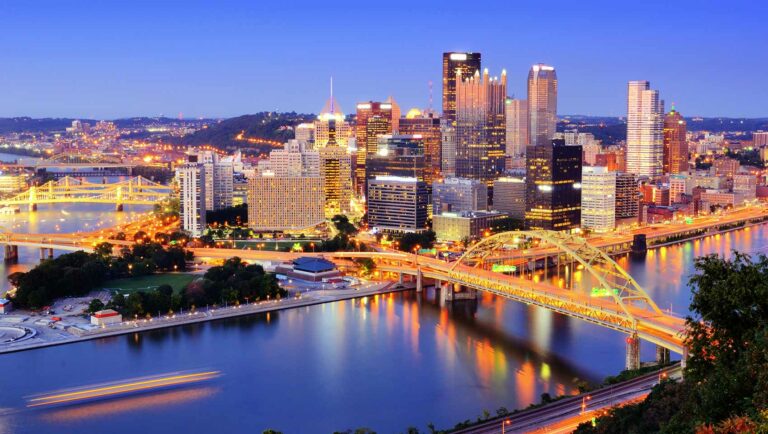Pittsburgh, Pennsylvania, once synonymous with its booming steel industry, has evolved into a diverse and exciting city brimming with cultural, historical, and natural attractions. As the confluence of three rivers—the Allegheny, Monongahela, and Ohio—Pittsburgh offers scenic beauty paired with a vibrant urban scene. The city’s unique geography, characterized by numerous hills and bridges, provides breathtaking views from almost every vantage point.
Over the last few decades, Pittsburgh has become a hub for education, technology, and the arts, while still celebrating its industrial heritage. Whether you’re a fan of world-class museums, stunning architecture, sports, or outdoor activities, this city has something for everyone. With its rich cultural tapestry, Pittsburgh invites visitors to explore its neighbourhoods, each offering a distinct personality and charm. This guide to the top 50 tourist attractions in Pittsburgh will take you through some of the most unforgettable experiences the Steel City has to offer.
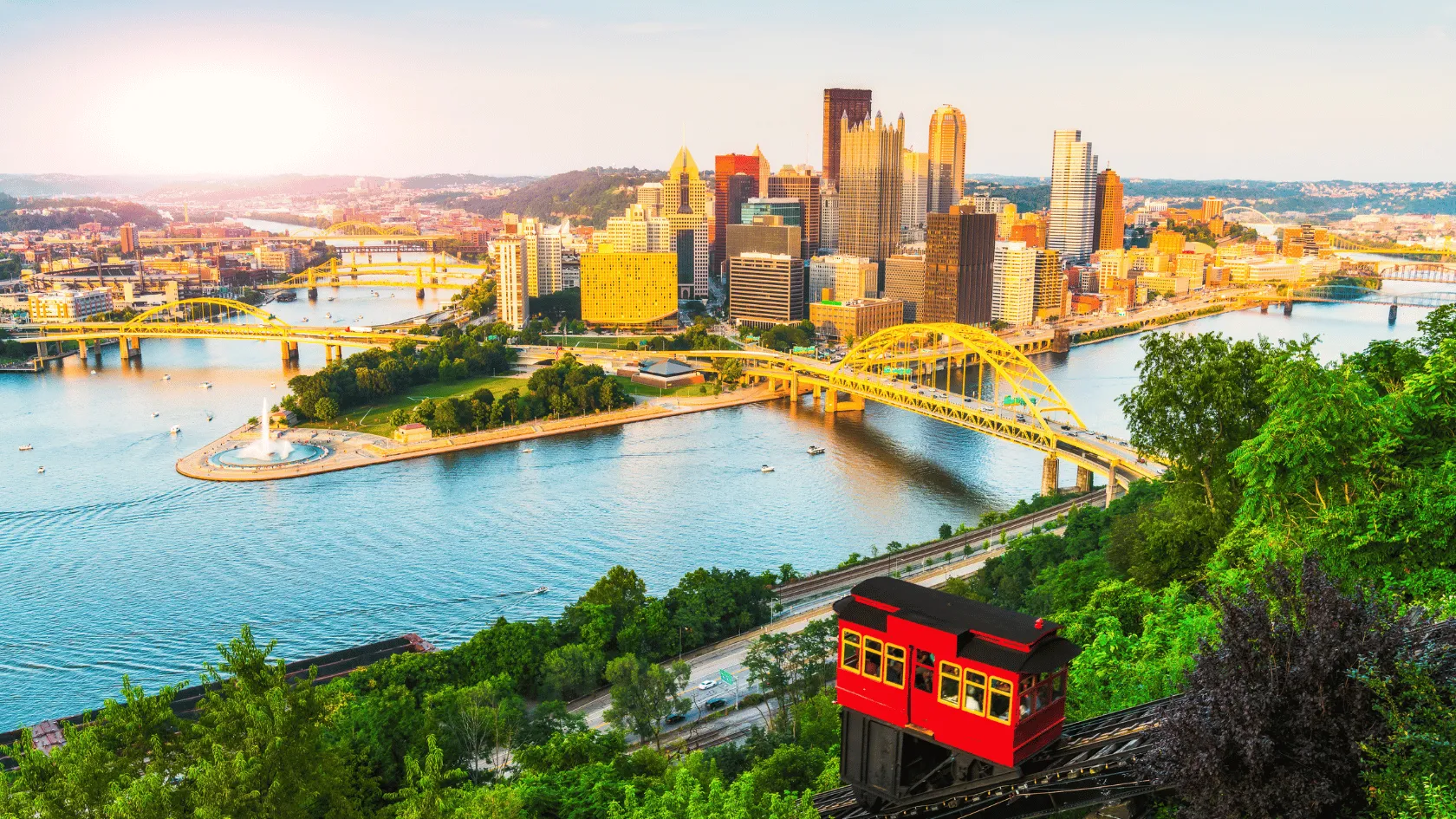
1. The Andy Warhol Museum
Dedicated to one of the most influential and provocative artists of the 20th century, The Andy Warhol Museum is a must-visit for contemporary art enthusiasts. As the largest museum in North America dedicated to a single artist, it celebrates the life and legacy of Pittsburgh native Andy Warhol. Visitors can explore seven floors of art, including Warhol’s famous works such as Campbell’s Soup Cans, Marilyn Monroe portraits, and Brillo Boxes. The museum also offers insights into Warhol’s influence on pop culture, film, music, and the avant-garde scene. With interactive exhibits, the museum provides a deep dive into his creative process and lasting impact on the art world.
2. Carnegie Museum of Natural History
Renowned for its impressive dinosaur exhibit, the Carnegie Museum of Natural History transports visitors back in time. The highlight of the museum is the Dinosaurs in Their Time exhibition, where life-sized skeletons of dinosaurs like the Tyrannosaurus rex and Diplodocus carnegii dominate the space. This exhibit is unique because the fossils are displayed in scientifically accurate poses, providing a dynamic look at how these creatures lived millions of years ago. The museum also boasts vast collections in palaeontology, geology, and anthropology, including gems, minerals, and historical artefacts from ancient civilizations. Whether you’re a curious child or an adult fascinated by Earth’s history, the museum offers a wealth of knowledge.
3. Phipps Conservatory and Botanical Gardens
A lush oasis in the middle of the city, Phipps Conservatory and Botanical Gardens offer a peaceful retreat into the world of plants and horticulture. Founded in 1893, the conservatory is a historic landmark that delights visitors with its seasonal flower shows, including the famous Spring Flower Show and Winter Light Garden. The glass-domed Victorian greenhouse is an architectural marvel, showcasing tropical plants, desert cacti, and even a Japanese garden. In addition to its themed rooms, the conservatory’s sustainable initiatives make it one of the greenest buildings in the world. Whether you’re exploring the butterfly forest or learning about sustainable gardening, Phipps offers something for all nature enthusiasts.
4. Mount Washington and the Duquesne Incline
For the best views in Pittsburgh, a trip up Mount Washington is essential. The Duquesne Incline, a 140-year-old funicular, offers a scenic and historic journey up the side of the mountain. Once at the top, visitors are treated to sweeping panoramic views of Pittsburgh’s skyline, rivers, and bridges, making it one of the most photographed locations in the city. The overlook is especially beautiful at sunset when the city lights up against the darkening sky. After soaking in the views, visitors can explore the residential neighbourhood of Mount Washington, which features upscale dining and quiet charm. The ride on the incline itself is a piece of Pittsburgh’s history, as it was originally used to transport workers to the factories below.
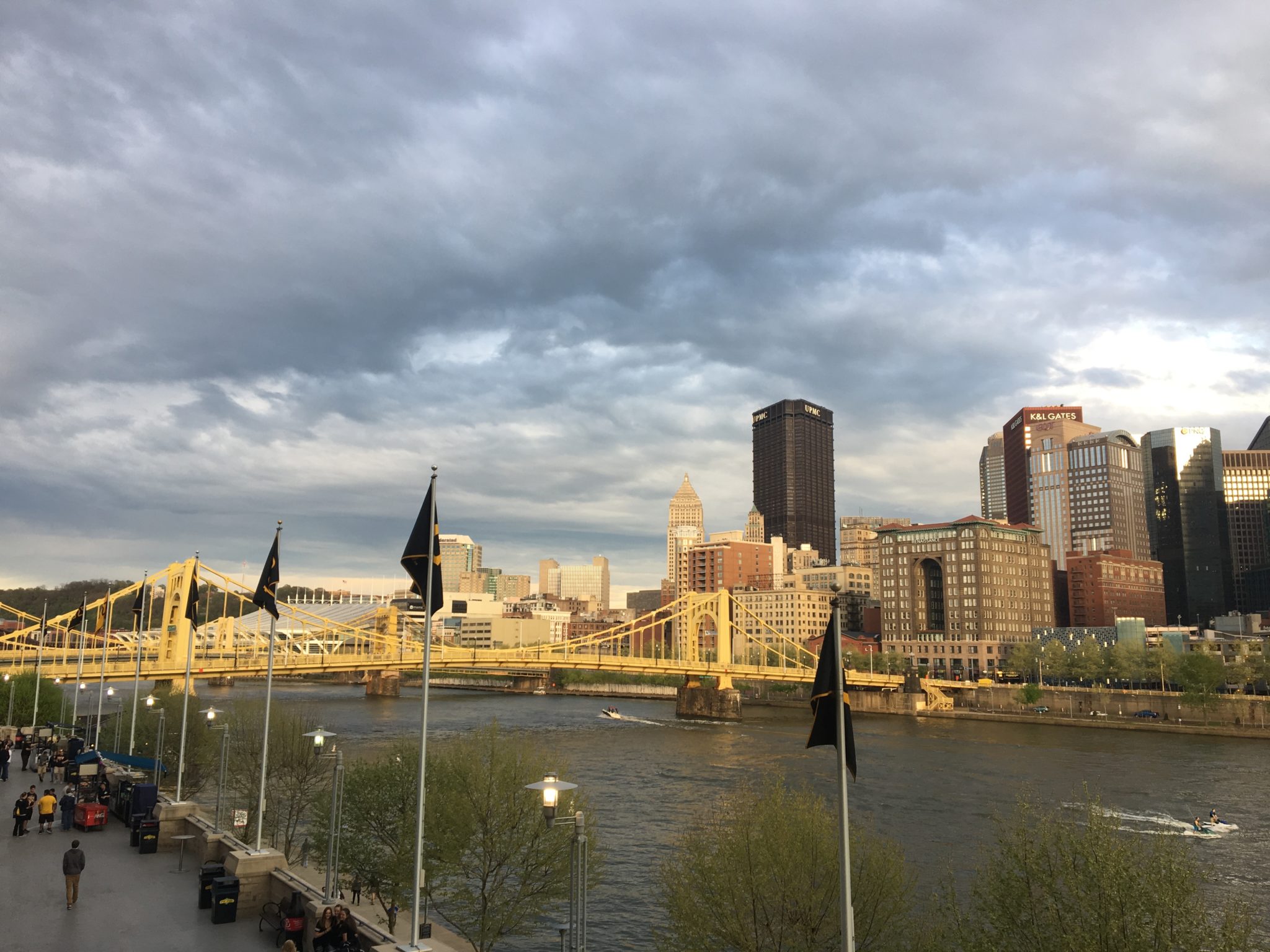
5. Heinz History Center
The Senator John Heinz History Center, affiliated with the Smithsonian Institution, is the largest history museum in Pennsylvania. Spanning six floors of interactive exhibits, the museum offers a deep dive into Western Pennsylvania’s rich heritage. From the role Pittsburgh played during the French and Indian War to the city’s steel boom, visitors can explore the region’s profound influence on American history. One of the museum’s most popular exhibits is dedicated to the Heinz family and their world-renowned condiment empire. The museum also has rotating exhibits, covering topics like sports history, Pittsburgh’s immigrant roots, and technological advancements.
6. Pittsburgh Zoo & PPG Aquarium
The Pittsburgh Zoo & PPG Aquarium is a family-friendly destination that combines the best of land and sea. Spanning 77 acres, the zoo is home to more than 4,000 animals from across the globe, including endangered species. Highlights include the African Savanna, where visitors can see majestic elephants, lions, and zebras in expansive enclosures. The aquarium is equally impressive, featuring marine life like sharks, sea turtles, and tropical fish. The zoo’s mission extends beyond entertainment, as it focuses on education, conservation, and the protection of endangered species.
7. Point State Park
Located at the convergence of Pittsburgh’s three rivers, Point State Park is a tranquil green space in the heart of the city. The park’s iconic fountain, which marks the beginning of the Ohio River, is a popular gathering spot. In addition to offering beautiful river views, the park is rich in history. It was the site of Fort Duquesne and Fort Pitt, both pivotal in the struggle between the British and French during the French and Indian War. Visitors can learn more about this history at the Fort Pitt Museum, located within the park. Point State Park also hosts numerous events throughout the year, including the annual Three Rivers Arts Festival.
8. The National Aviary
As the largest aviary in the United States, the National Aviary offers an extraordinary opportunity to get up close to birds from around the world. Home to over 500 birds representing more than 150 species, the aviary is known for its immersive exhibits, where birds fly freely around visitors. The Tropical Rainforest exhibit features vibrant species like toucans and parrots, while the Grasslands exhibit showcases birds native to open plains, such as eagles and owls. The aviary also plays a vital role in avian conservation, conducting breeding programs and rehabilitation efforts for endangered species. Visitors can participate in special experiences like feeding sessions or encounters with birds of prey.

9. Strip District
Pittsburgh’s Strip District is a lively and eclectic neighbourhood that reflects the city’s cultural diversity. Once a hub for industrial produce markets, the area has transformed into a bustling shopping and dining destination. Visitors can find everything from artisanal cheeses, fresh seafood, and spices to speciality shops offering global cuisine. The area is a foodie’s paradise, with popular spots like Primanti Brothers, famous for its sandwiches piled high with coleslaw and fries. The Strip District is also home to numerous ethnic grocery stores and markets, reflecting the neighbourhood’s immigrant roots. On weekends, the area is particularly vibrant, with open-air vendors, street performances, and a festival-like atmosphere.
10. Cathedral of Learning
The towering Gothic revival architecture of the Cathedral of Learning is a defining feature of the University of Pittsburgh’s campus. At 42 stories, it is the second tallest university building in the world, offering sweeping views of the city from its higher floors. Inside, the Cathedral of Learning is equally awe-inspiring, particularly the Nationality Rooms. These 31 classrooms are each designed to reflect the culture and history of different countries, offering visitors a glimpse into global traditions. The classrooms feature intricate craftsmanship, with details like carved wood, stained glass, and traditional furnishings. The Cathedral serves as both a functioning academic building and a public attraction, blending education with cultural appreciation.
11. Kennywood Amusement Park
As one of the oldest amusement parks in the United States, Kennywood holds a special place in Pittsburgh’s heart. Opened in 1898, the park retains much of its old-world charm, with classic rides like the Thunderbolt and Jack Rabbit, two wooden roller coasters that have thrilled generations of visitors. In addition to its vintage attractions, Kennywood offers modern thrill rides, family-friendly activities, and water rides. The park is particularly magical during seasonal events like Phantom Fright Nights in the fall and Holiday Lights in the winter, when the entire park is transformed with festive decorations and entertainment.
12. Fort Pitt Museum
Situated within Point State Park, the Fort Pitt Museum tells the story of Pittsburgh’s role in the French and Indian War and its strategic importance during America’s westward expansion. The museum’s exhibits take visitors back to the 18th century, offering insights into the lives of soldiers, traders, and Native Americans who lived and worked at the fort. Visitors can explore artefacts from the period, including weapons, clothing, and tools. Outside the museum, a reconstructed bastion offers a glimpse into what the original fort would have looked like. For history buffs, the Fort Pitt Museum is a fascinating stop that highlights Pittsburgh’s military past.
13. The Mattress Factory
For contemporary art lovers, the Mattress Factory is a must-see. This avant-garde museum specializes in immersive, room-sized installations that challenge the boundaries of traditional art. Located in a former mattress warehouse, the museum provides space for artists to create site-specific works that engage all the senses. Notable installations include Yayoi Kusama’s Infinity Dots Mirrored Room and James Turrell’s Pleiades, both of which invite visitors to lose themselves in sensory experiences. The museum also supports emerging artists, offering residencies that encourage experimental and innovative works. The Mattress Factory is a place where art is meant to be experienced rather than simply observed.

14. Randyland
One of Pittsburgh’s most colourful and unique attractions, Randyland is the creation of artist Randy Gilson, who transformed his North Side property into an outdoor art museum. The bright and whimsical space features vibrant murals, found-object sculptures, and upcycled art installations that reflect Randy’s joyful and eccentric personality. Visitors are encouraged to wander through the space, take photos, and interact with the art. Randyland is a symbol of creativity and community, with its message of positivity and inclusiveness. It’s one of the most Instagrammable spots in the city, and its quirky charm makes it a beloved Pittsburgh institution.
15. The Frick Pittsburgh
Step back into the Gilded Age with a visit to The Frick Pittsburgh, a cultural complex located in the historic neighbourhood of Point Breeze. The site includes the Frick Art Museum, which houses an impressive collection of European paintings and decorative arts, and Clayton, the restored mansion of industrialist Henry Clay Frick. Visitors can tour the mansion to get a glimpse of the luxurious lifestyle of one of Pittsburgh’s most prominent families during the late 19th century. The Frick also offers beautifully landscaped gardens, a car and carriage museum, and rotating art exhibitions, making it a perfect destination for art and history lovers alike.
16. Market Square
In the heart of downtown Pittsburgh, Market Square serves as a lively hub for dining, shopping, and entertainment. The historic square, which dates back to the 18th century, has been revitalized into a pedestrian-friendly space that hosts events year-round, including farmers’ markets, outdoor concerts, and holiday festivals. Market Square is surrounded by a mix of restaurants, cafes, and boutiques, making it a great place to grab a bite to eat or people-watch. During the warmer months, the square’s outdoor seating areas fill up with locals and tourists alike, adding to the vibrant atmosphere.
17. Pittsburgh Glass Center
A hidden gem for those interested in art and craftsmanship, the Pittsburgh Glass Center offers visitors an immersive experience in the world of glass art. This centre is not just a gallery but also a fully functioning glassblowing studio where visitors can watch artists at work, attend workshops, or even try their hand at creating glass art themselves. The studio hosts both short-term classes for beginners and more intensive courses for serious students of glassblowing. The exhibitions feature stunning glass creations from artists around the world, with pieces ranging from intricately blown glass sculptures to contemporary glass art installations. Whether you are interested in the history of glassmaking or modern applications of the craft, the Pittsburgh Glass Center is a fascinating and interactive experience.
18. Carnegie Science Center
For those with a curiosity for science, technology, and space, the Carnegie Science Center is one of Pittsburgh’s top attractions. Located on the North Shore along the Ohio River, the centre is home to over 250 hands-on exhibits that engage visitors of all ages. Among its most popular exhibits is the Buhl Planetarium, which offers mesmerizing shows about the cosmos, from exploring the Milky Way to understanding black holes. The science centre is also home to the Miniature Railroad & Village, a model railroad exhibit that has been a Pittsburgh favourite for decades, featuring detailed replicas of Western Pennsylvania landmarks. Additionally, visitors can tour the USS Requin, a World War II-era submarine docked outside the science centre, offering a glimpse into life aboard a naval vessel. Whether you are a space enthusiast, an aspiring scientist, or a history buff, the Carnegie Science Center offers an entertaining and educational experience.
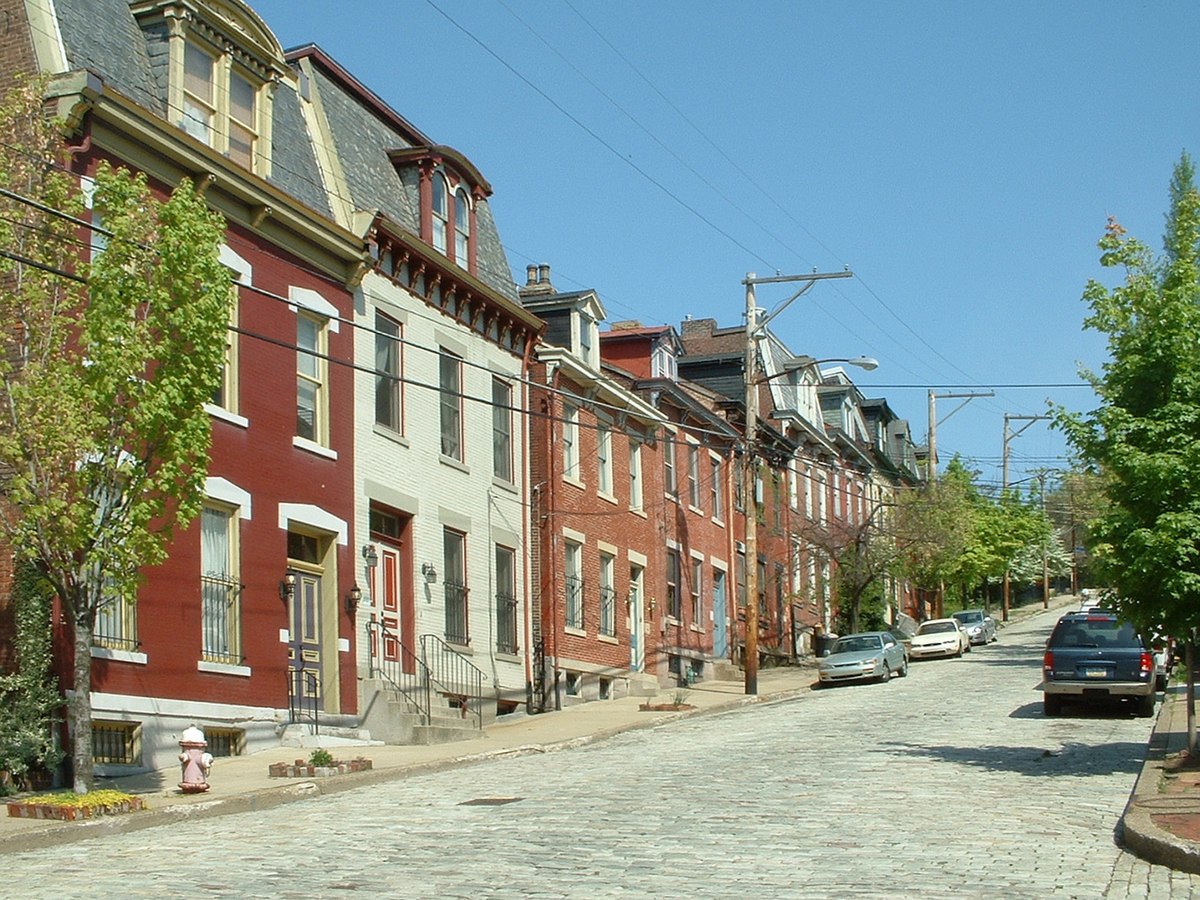
19. Schenley Park
Spanning over 450 acres, Schenley Park is one of Pittsburgh’s largest and most beautiful green spaces. Located near the University of Pittsburgh, this park offers a wide range of outdoor activities, including hiking, biking, and even ice skating in the winter. The park’s rolling hills, wooded trails, and open fields make it an ideal spot for picnics, nature walks, or simply relaxing. Within the park, you’ll find attractions like the Phipps Conservatory and Botanical Gardens and the Schenley Oval Sportsplex, which features an ice skating rink in the winter and a running track during warmer months. The park also hosts numerous cultural events and festivals, including the annual Vintage Grand Prix, which brings vintage car enthusiasts to Pittsburgh every summer.
20. Roberto Clemente Museum
Baseball fans visiting Pittsburgh will not want to miss the Roberto Clemente Museum, dedicated to the legendary Pittsburgh Pirates outfielder and humanitarian. The museum is housed in a renovated firehouse in the Lawrenceville neighbourhood and showcases an extensive collection of memorabilia from Clemente’s career. Visitors can see his game-worn jerseys, personal items, and awards, including his Gold Gloves and MVP trophies. The museum also honours Clemente’s humanitarian efforts, particularly his work in Latin America, and his tragic death in a plane crash while delivering aid to earthquake victims in Nicaragua. The intimate setting of the museum allows for a deeply personal connection to Clemente’s life and legacy, making it a must-see for sports enthusiasts and those inspired by his contributions off the field.
21. Allegheny Cemetery
As one of the largest and oldest cemeteries in Pittsburgh, Allegheny Cemetery is not only a final resting place for many prominent Pittsburghers but also a serene and beautiful park for reflection. Founded in 1844, the cemetery covers over 300 acres and is the burial site of many notable figures, including industrialists, artists, and war heroes. The grounds feature ornate mausoleums, historic monuments, and beautifully landscaped paths, making it a peaceful place for a stroll or a quiet moment of contemplation. Visitors can also take guided tours to learn about the cemetery’s history and the stories of those buried there. The cemetery’s historic significance and tranquil atmosphere make it a unique and solemn Pittsburgh landmark.
22. Children’s Museum of Pittsburgh
A vibrant destination for families, the Children’s Museum of Pittsburgh is an interactive wonderland designed to spark creativity and imagination in children of all ages. Located on the North Side, the museum offers a wide variety of exhibits that encourage hands-on learning through play. Children can explore everything from art and sculpture to science and technology in a series of themed rooms and workshops. The museum’s Waterplay exhibit allows kids to experiment with water flow and physics, while the Makeshop encourages them to create with tools, textiles, and electronics. The museum also features a garden and outdoor play area where children can interact with nature. Parents will appreciate the museum’s thoughtful design, which blends education with fun in a way that engages young minds.
23. Heinz Field
Home to the Pittsburgh Steelers of the NFL and the University of Pittsburgh Panthers football team, Heinz Field is an iconic sports venue located on the North Shore. Opened in 2001, the stadium seats over 68,000 fans and is known for its lively game-day atmosphere, especially when the Steelers take the field. Beyond football, Heinz Field also hosts concerts and other major events throughout the year. Visitors can take a behind-the-scenes tour of the stadium, which includes stops at the locker rooms, the press box, and a walk along the field. The stadium’s location along the Ohio River provides stunning views of the water and downtown Pittsburgh, making it a memorable stop for sports enthusiasts and tourists alike.
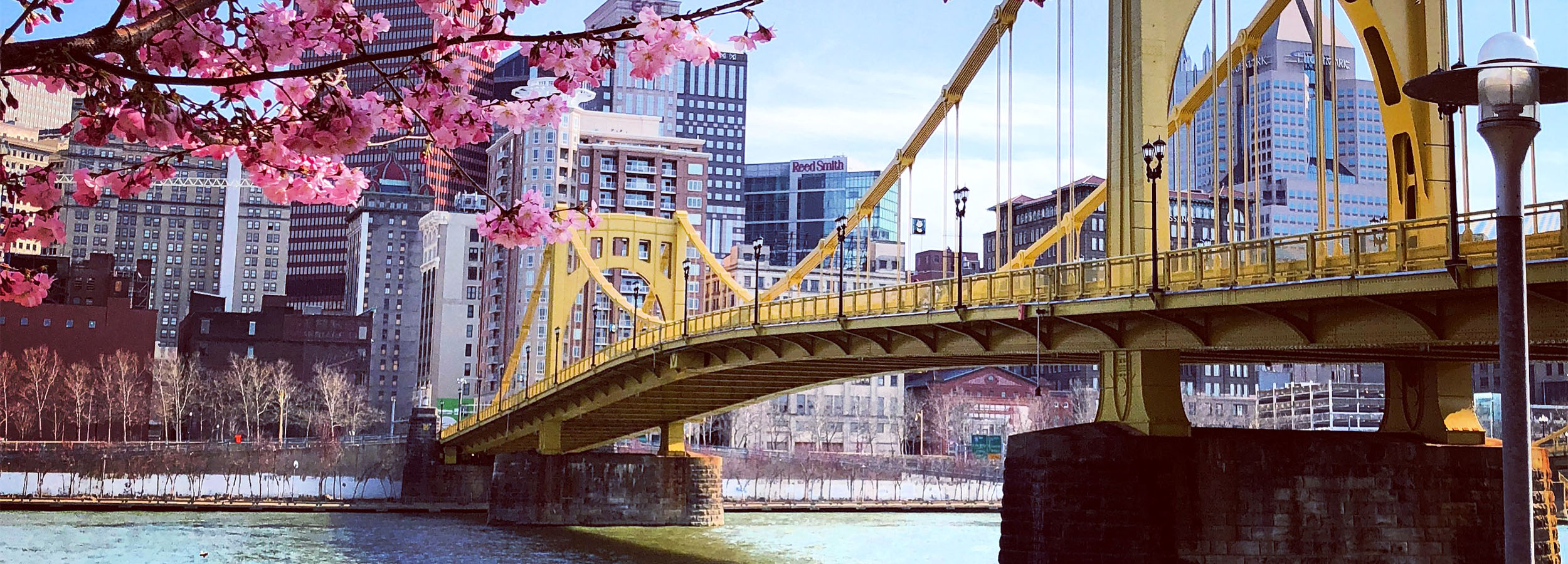
24. The Strip District Terminal
The Strip District is one of Pittsburgh’s most beloved neighbourhoods, and its revitalized Terminal building serves as a new focal point. The Terminal is a historic warehouse that has been transformed into a lively retail and dining destination. Visitors can shop for local goods, enjoy a meal at one of the many eateries, or attend events that bring the community together. The Strip District has long been known for its open-air markets, and the Terminal preserves that tradition while adding a modern twist. From grabbing a coffee at a boutique café to purchasing local artisan goods, the Terminal is a great place to spend an afternoon exploring.
25. Pittsburgh Ballet Theatre
For fans of the performing arts, the Pittsburgh Ballet Theatre (PBT) is one of the city’s premier cultural institutions. Founded in 1969, PBT presents a variety of performances each season, ranging from classic ballets like Swan Lake and The Nutcracker to contemporary works by leading choreographers. The ballet company performs at the Benedum Center in the Cultural District, a grand venue that adds to the magic of the performance experience. During the summer months, PBT offers outdoor performances in parks throughout the city, providing a unique and accessible way for audiences to enjoy the beauty of dance. The company also offers educational programs for aspiring dancers, making it an integral part of Pittsburgh’s arts community.
26. The Monongahela Incline
Another must-see for visitors wanting to capture Pittsburgh’s spectacular views is the Monongahela Incline. This historic incline, which has been in operation since 1870, takes passengers up the side of Mount Washington, offering breathtaking views of the city’s skyline and rivers along the way. The Monongahela Incline is particularly popular for its convenience, as it is located near Station Square, a bustling area with shops, restaurants, and riverfront attractions. The incline has been a vital part of Pittsburgh’s transportation system for over a century, providing an enduring link between the city and the neighbourhoods perched atop Mount Washington. Riding the incline offers a unique glimpse into Pittsburgh’s industrial past while providing some of the best photo opportunities in the city.
27. The Frick Environmental Center
At the edge of Frick Park, the Frick Environmental Center is an educational and eco-friendly hub for those interested in learning about sustainability and the environment. The building itself is a marvel of sustainable design, as it is certified as a Living Building, meaning it operates with a net-positive energy and water usage. Visitors can take guided tours of the centre to learn about its green building techniques, or participate in workshops and programs focused on conservation, wildlife, and sustainable gardening. The surrounding park provides plenty of trails and natural areas to explore, making it a perfect destination for nature lovers and those looking to reconnect with the environment.
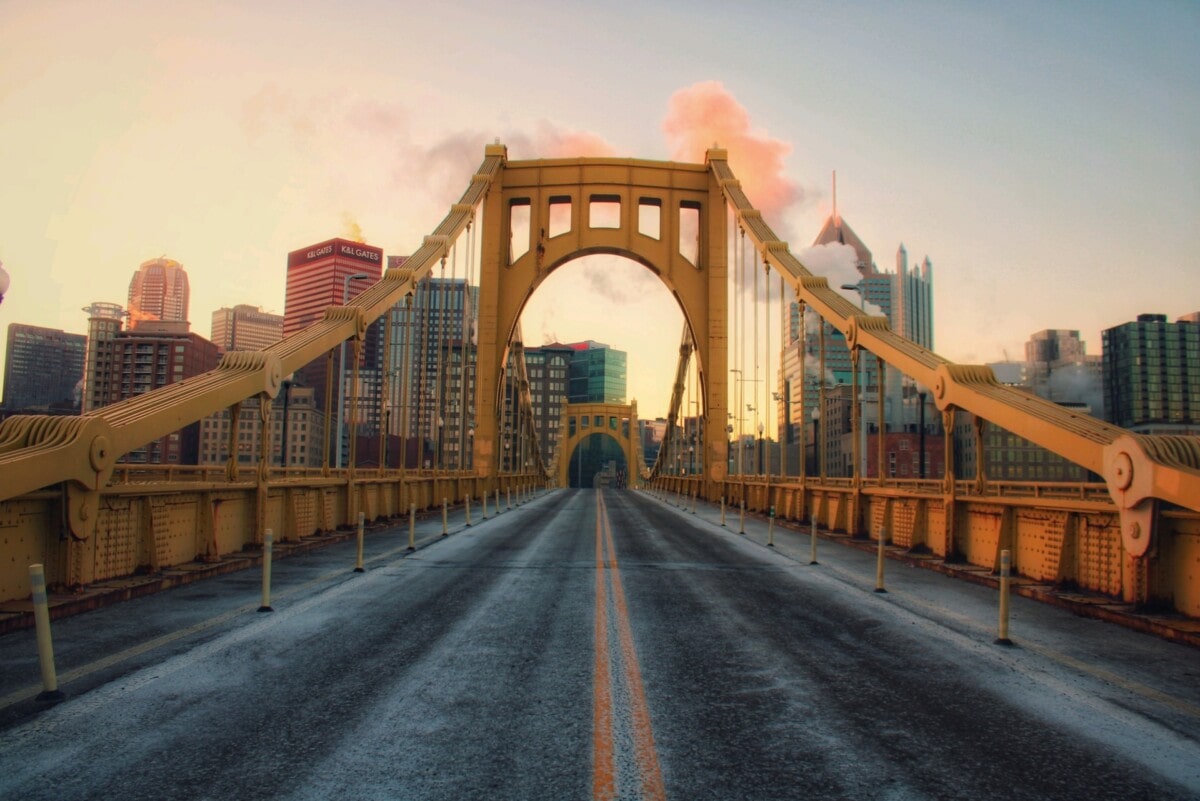
28. The Nationality Rooms at the University of Pittsburgh
Housed within the majestic Cathedral of Learning, the Nationality Rooms offer a unique cultural experience in the heart of the University of Pittsburgh. Each of the 31 rooms represents the cultural heritage of a different country or ethnic group, with meticulously crafted designs and authentic materials. The rooms serve as functional classrooms, but they are also open to the public for tours. Whether you are exploring the Japanese Room with its traditional tatami mats and paper screens or the Ukrainian Room with its rich wood carvings and religious icons, the Nationality Rooms provide a window into global traditions and artistry. The rooms are particularly popular during the holiday season when they are decorated to reflect the various cultural celebrations.
29. Carnegie Museum of Art
Sharing a building with the Carnegie Museum of Natural History, the Carnegie Museum of Art is one of the most distinguished art museums in the country. Founded by industrialist Andrew Carnegie in 1895, the museum was one of the first in the U.S. to focus on contemporary art. Today, the museum’s collection spans centuries and continents, with works ranging from European masters to modern and contemporary pieces. The museum is particularly known for its collection of American art, decorative arts, and photography. Special exhibitions often highlight emerging artists or explore new trends in the art world. Whether you’re an art aficionado or a casual visitor, the Carnegie Museum of Art offers an inspiring and thought-provoking experience.
30. Soldiers & Sailors Memorial Hall & Museum
Dedicated to honouring the service and sacrifice of American veterans, Soldiers & Sailors Memorial Hall & Museum is a unique cultural and historical landmark in Pittsburgh. The building itself is a striking Beaux-Arts structure, and inside, visitors will find exhibits that cover U.S. military history from the Civil War to the present day. The museum’s artefacts range from uniforms and weapons to personal letters and photographs, providing a deeply personal connection to the experiences of soldiers throughout history. In addition to its permanent exhibits, Soldiers & Sailors hosts events, lectures, and performances that celebrate veterans and their contributions to the country.
31. Carrie Blast Furnaces
Standing as a testament to Pittsburgh’s industrial past, the Carrie Blast Furnaces are a fascinating relic of the city’s once-booming steel industry. Located in the nearby town of Rankin, the furnaces operated from 1884 to 1982 and were an integral part of the U.S. steel production that helped build modern America. Now designated a National Historic Landmark, these towering blast furnaces are preserved as part of the Rivers of Steel National Heritage Area. Guided tours allow visitors to explore the massive industrial complex, offering a glimpse into the harsh working conditions and innovative technology that defined Pittsburgh’s steel era. Special programs, including iron casting workshops and art installations, breathe new life into this industrial giant, making it a must-see for history buffs and anyone interested in Pittsburgh’s industrial roots.
32. Trundle Manor
If you’re looking for something a bit offbeat and quirky, Trundle Manor is one of Pittsburgh’s most unique and bizarre attractions. A private home turned “house of oddities,” Trundle Manor houses a collection of eccentric items, including taxidermy, vintage medical equipment, and odd relics from various eras. The owners, who act as curators and tour guides, offer personalized tours that blend dark humour with macabre curiosities. The eclectic assortment of unusual objects creates a museum-like atmosphere, and visitors can expect to see everything from steampunk creations to antique weaponry. With its mix of art, history, and eccentricity, Trundle Manor is the place to go if you’re seeking something truly unconventional in Pittsburgh.
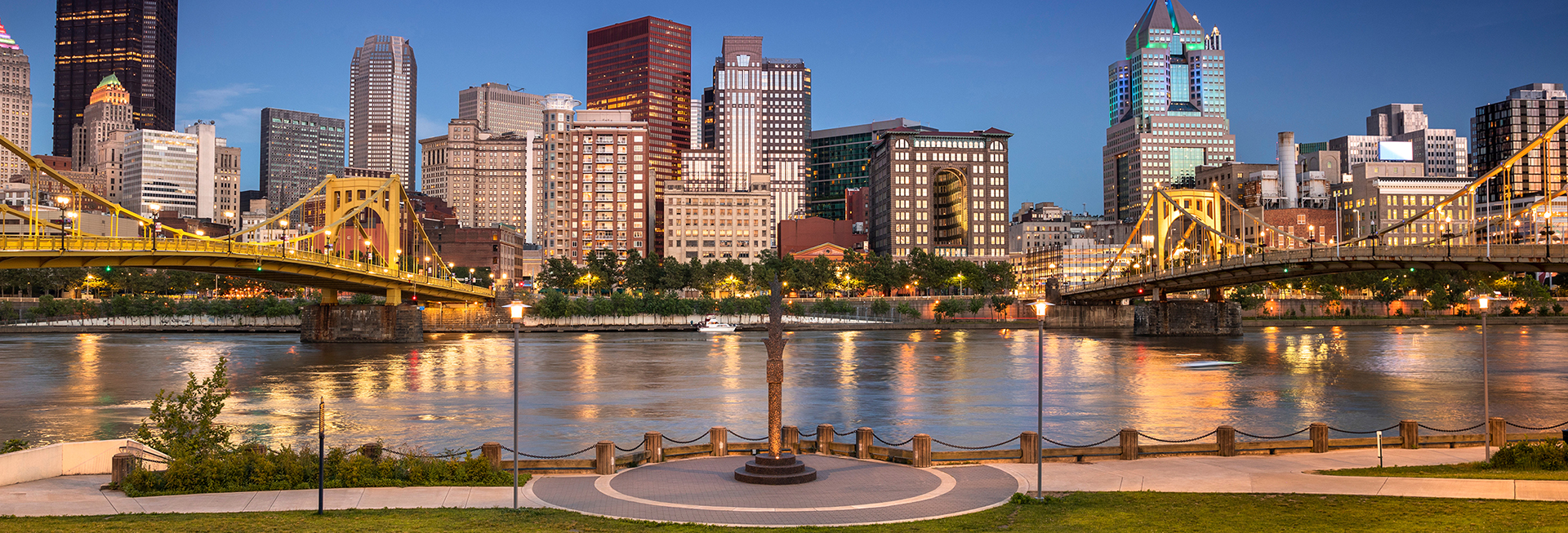
33. Pittsburgh Botanic Garden
Located about 20 minutes outside downtown, the Pittsburgh Botanic Garden is a peaceful escape into nature. This 460-acre garden offers meticulously cultivated landscapes that showcase the native plants of the Appalachian Plateau. Visitors can stroll through various themed gardens, such as the Meadow Garden and Woodland Garden, and take in the stunning seasonal changes that make each visit unique. The Lotus Pond and Heritage Homestead, which features a 1784 log house, offer a glimpse into the region’s history and natural beauty. The garden also emphasizes environmental sustainability and restoration, working to reclaim former coal mining land into thriving natural habitats. It’s an ideal destination for garden enthusiasts, photographers, or anyone in need of a serene nature retreat.
34. Station Square
Sitting along the Monongahela River, Station Square is a lively hub of activity in Pittsburgh’s South Shore. Once a major railroad terminal, this historic site has been transformed into a mixed-use area featuring restaurants, shops, and entertainment venues. The old train tracks and preserved railway architecture offer a nod to Pittsburgh’s industrial past, while the modern amenities make it a popular destination for dining, shopping, and nightlife. Visitors can catch live music performances, dine at waterfront restaurants, or explore the historic Grand Concourse. For a memorable experience, take a ride on one of the Just Ducky Tours that depart from Station Square, offering a quirky way to explore the city’s rivers and streets aboard an amphibious vehicle.
35. South Side Works
South Side Works is a vibrant mixed-use development that combines retail, dining, and entertainment in one of Pittsburgh’s trendiest areas. Located along the riverfront, this modern complex is known for its stylish shops, outdoor cafes, and a lively nightlife scene. Whether you’re looking to shop for the latest fashions, enjoy a meal at one of the many restaurants, or catch a movie at the cinema, South Side Works has something for everyone. During the warmer months, the area comes alive with outdoor concerts, festivals, and events. The scenic river views and pedestrian-friendly layout make it an ideal place to spend an afternoon or evening enjoying Pittsburgh’s more modern and cosmopolitan side.
36. Three Rivers Heritage Trail
The Three Rivers Heritage Trail is one of Pittsburgh’s best outdoor recreational assets, offering a 33-mile multi-use trail system that follows the banks of the city’s iconic rivers. Whether you’re a cyclist, jogger, or casual walker, the trail provides a scenic route through Pittsburgh’s urban landscape and connects many of the city’s parks and attractions. The trail offers fantastic views of the rivers, bridges, and skyline, making it a popular spot for both exercise and leisure. There are also several historical markers along the trail, providing insights into Pittsburgh’s history as a trading post and industrial hub. Whether you’re looking to explore nature, enjoy a quiet moment by the river, or navigate the city on foot, the Three Rivers Heritage Trail is an ideal way to experience Pittsburgh’s outdoor beauty.
37. Heinz Memorial Chapel
Located on the University of Pittsburgh’s campus, Heinz Memorial Chapel is an architectural gem and one of the most beautiful chapels in the country. Built in the 1930s by the Heinz family in memory of their mother, the chapel is a Gothic revival masterpiece, known for its soaring ceilings, intricate stonework, and stunning stained-glass windows. The windows, which depict scenes from both the Old and New Testament, are among the largest stained-glass installations in the world, bathing the interior of the chapel in vibrant colours. The chapel is a popular site for weddings, concerts, and other special events, but it is also open to the public for tours and quiet reflection. It’s a serene and breathtaking spot that should not be missed by architecture lovers or those seeking a peaceful respite in the city.
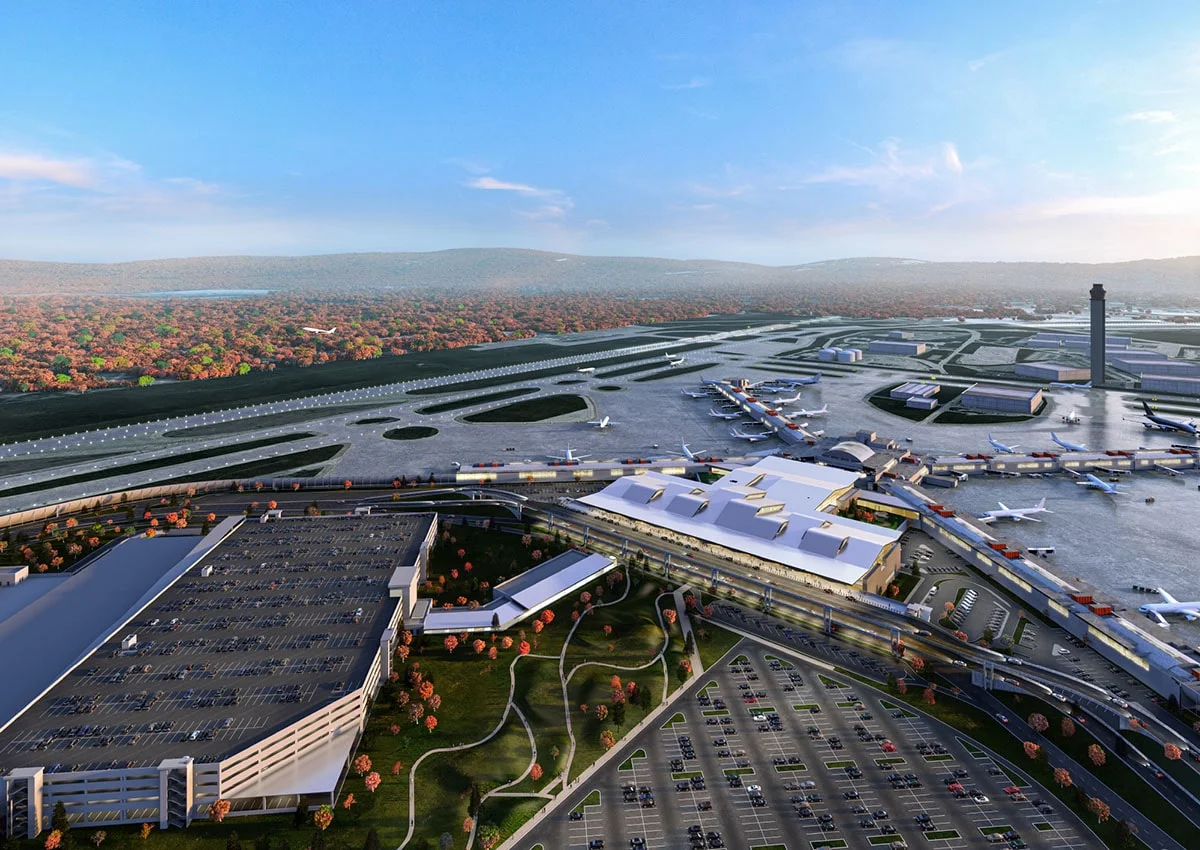
38. Hartwood Acres Park
Located just outside Pittsburgh, Hartwood Acres Park is a 629-acre county park known for its natural beauty and cultural events. The park’s centrepiece is the Hartwood Mansion, a grand Tudor-style estate built in the 1920s. Visitors can take guided tours of the mansion, which is filled with period furnishings and artwork, or explore the surrounding gardens and trails. Hartwood Acres is also known for its outdoor sculpture collection, with pieces from both local and international artists scattered throughout the park. During the summer months, the park hosts outdoor concerts, theatre performances, and festivals, making it a cultural hub as well as a natural retreat. The blend of history, art, and nature makes Hartwood Acres Park a perfect destination for a relaxing day trip.
39. The Clemente Bridge
Named in honour of Pittsburgh Pirates legend Roberto Clemente, the Clemente Bridge is one of the iconic “Three Sisters” bridges that span the Allegheny River. Painted in bright yellow and designed in the style of self-anchored suspension bridges, it connects downtown Pittsburgh to the North Shore, home of PNC Park. On game days, the bridge is closed to vehicular traffic, transforming it into a pedestrian walkway packed with Pirates fans heading to the ballpark. The views of the Allegheny River, the downtown skyline, and the stadiums make it one of the most picturesque spots in the city. The Clemente Bridge is not only a tribute to one of Pittsburgh’s greatest athletes but also a symbol of the city’s connection to its waterfront and its vibrant sports culture.
40. PNC Park
PNC Park, home of the Pittsburgh Pirates, is widely regarded as one of the most beautiful baseball stadiums in America. Situated along the Allegheny River, the ballpark offers spectacular views of the downtown skyline and the surrounding bridges, making it a fantastic venue for taking in a game or just soaking up the atmosphere. The park’s intimate seating arrangement, with a capacity of just over 38,000, ensures that every seat offers great sightlines of the field. PNC Park also boasts a wide array of dining options, featuring local favourites like Primanti Brothers sandwiches and Manny’s BBQ. Whether you’re a die-hard baseball fan or just looking to enjoy a quintessential Pittsburgh experience, catching a game at PNC Park is a must.
41. The Senator John Heinz History Center Sports Museum
Housed within the Heinz History Center, the Western Pennsylvania Sports Museum is a treasure trove of Pittsburgh’s sports history. This 20,000-square-foot exhibit is dedicated to the city’s legendary sports teams, athletes, and moments. From the Super Bowl victories of the Pittsburgh Steelers to the Stanley Cup triumphs of the Penguins and the baseball legacy of the Pirates, the museum captures the passion and pride of Pittsburgh sports fans. Visitors can explore memorabilia, including game-worn jerseys, championship trophies, and historical artefacts from Western Pennsylvania’s sports history. The museum also highlights lesser-known sports heroes and events, providing a comprehensive look at the region’s rich athletic tradition.
42. Wood Street Galleries
Located in the heart of downtown Pittsburgh’s Cultural District, Wood Street Galleries is an innovative art space that specializes in new media, video art, and interactive installations. The gallery is housed in a former railroad station, and its minimalist industrial interior provides the perfect backdrop for cutting-edge contemporary art. The exhibitions at Wood Street Galleries often feature international artists exploring themes of technology, society, and the intersection of art and science. Visitors can expect thought-provoking and immersive experiences that challenge traditional notions of art. The gallery’s focus on digital and experimental art makes it one of the most unique cultural spaces in Pittsburgh.

43. Lawrenceville
Once an industrial hub, Lawrenceville has undergone a renaissance in recent years, transforming into one of Pittsburgh’s trendiest neighbourhoods. This historic district is known for its eclectic mix of art galleries, independent boutiques, vintage shops, and locally-owned restaurants. Butler Street, the neighbourhood’s main thoroughfare, is a vibrant corridor where you’ll find everything from handcrafted goods to craft breweries and hip cafes. The neighbourhood is also home to a thriving arts scene, with murals, public art installations, and regular gallery exhibitions. Lawrenceville’s blend of historic charm and modern creativity makes it a hotspot for young professionals, artists, and visitors looking to experience Pittsburgh’s urban cool.
44. Bicycle Heaven
Touted as the world’s largest bicycle museum, Bicycle Heaven is a haven for cycling enthusiasts and collectors alike. Located in Pittsburgh’s North Side, this quirky museum and bike shop houses thousands of vintage and rare bicycles, spanning over a century of cycling history. Visitors can marvel at iconic models, including classic Schwinns, high-wheelers from the 19th century, and even bikes that have appeared in films. The museum also features a treasure trove of bicycle memorabilia, including antique parts, posters, and cycling-related toys. Whether you’re a serious cyclist or just enjoy a bit of nostalgia, Bicycle Heaven is an unexpected and delightful stop.
45. Shadyside
Shadyside is one of Pittsburgh’s most fashionable and upscale neighbourhoods, known for its tree-lined streets, historic homes, and trendy shopping districts. The neighbourhood’s main commercial areas, Walnut Street and Ellsworth Avenue, are lined with high-end boutiques, chic cafes, and gourmet restaurants. Shadyside’s blend of old-world charm and modern amenities makes it a favourite destination for shopping, dining, and people-watching. The neighbourhood is also home to many of Pittsburgh’s most beautiful historic homes, including Victorian mansions and early 20th-century estates, making it a great place for an afternoon walk or architectural tour.
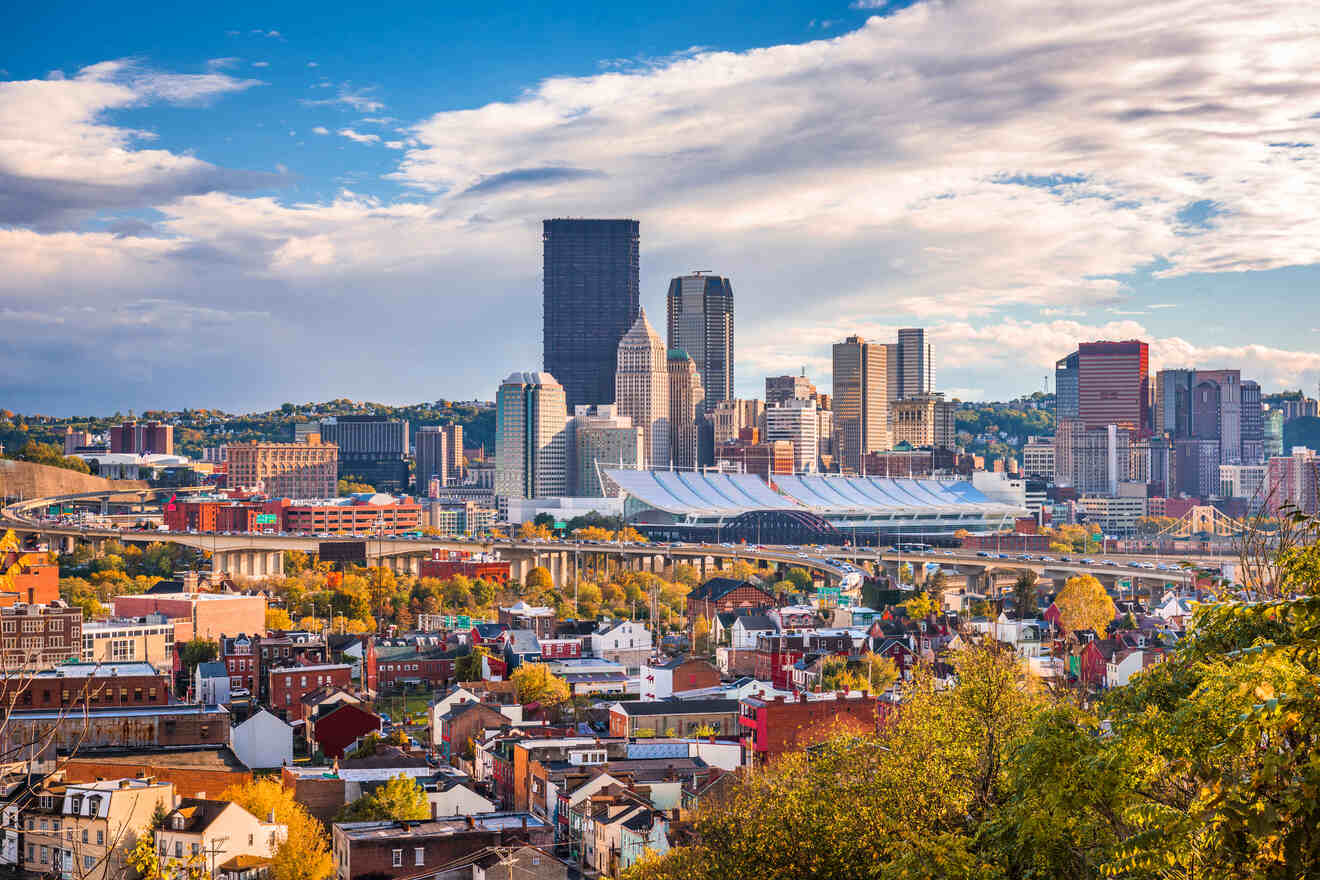
46. The Pittsburgh Playhouse
Located in the city’s Cultural District, the Pittsburgh Playhouse is a vibrant hub for theatre and the performing arts. Operated by Point Park University, the Playhouse stages a diverse array of productions throughout the year, ranging from classic plays to contemporary performances and musicals. The theatre is known for its commitment to fostering emerging talent, with many of the performances featuring students from the university’s renowned conservatory programs. Whether you’re in the mood for a Shakespearean tragedy or a cutting-edge new work, the Pittsburgh Playhouse offers an enriching cultural experience in an intimate setting.
47. Pittsburgh Public Market
Located in the Strip District, the Pittsburgh Public Market is a food lover’s paradise. This bustling indoor market features vendors selling a wide range of local and artisanal products, including fresh produce, baked goods, cheeses, meats, and prepared foods. Visitors can sample Pittsburgh’s culinary staples, such as pierogies and sausages, or try more exotic offerings like handmade chocolates and international cuisine. The market also hosts regular cooking demonstrations, workshops, and tastings, making it a fun and interactive place to explore. Whether you’re stocking up on local delicacies or simply enjoying the lively atmosphere, the Pittsburgh Public Market is a great place to experience the city’s diverse food scene.
48. The Mexican War Streets
The Mexican War Streets is a historic district located in Pittsburgh’s North Side, known for its beautifully preserved 19th-century row houses and cobblestone streets. The neighbourhood’s unique name comes from the streets being named after battles and generals from the Mexican-American War. Walking through the Mexican War Streets feels like stepping back in time, with its ornate ironwork, intricate brickwork, and charming gardens. The neighbourhood is also home to several small parks and community spaces, offering a peaceful retreat from the hustle and bustle of the city. For architecture enthusiasts, the Mexican War Streets are a must-visit destination.
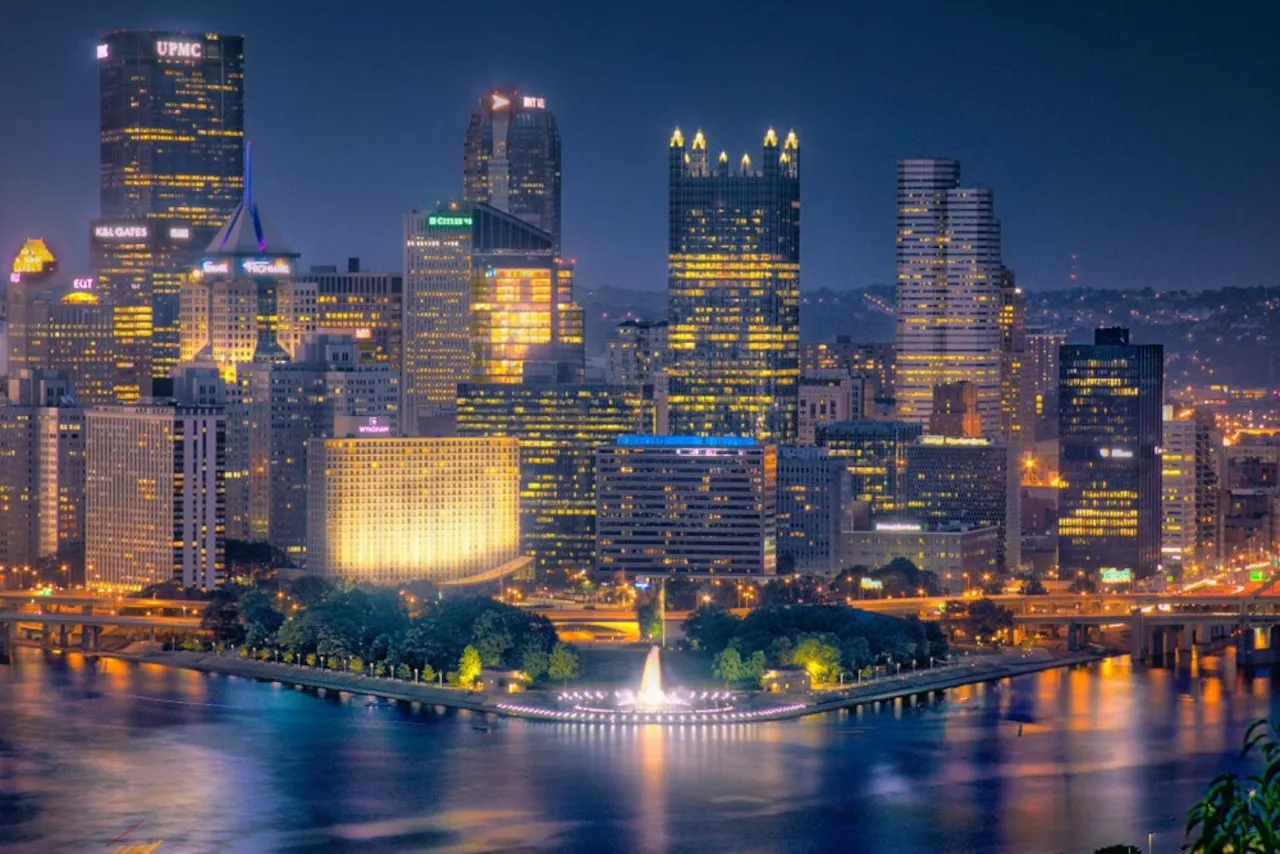
49. The David L. Lawrence Convention Center
Sitting along the banks of the Allegheny River in downtown Pittsburgh, the David L. Lawrence Convention Center is an architectural marvel and a hub for conferences, exhibitions, and events. This award-winning building is one of the largest LEED-certified convention centres in the world, boasting an innovative design that integrates natural light, eco-friendly materials, and stunning views of the river. Visitors attending events at the convention centre can enjoy its state-of-the-art facilities, along with easy access to nearby restaurants, shops, and attractions in the Cultural District. The building’s eco-friendly design and picturesque location make it a standout example of modern architecture in Pittsburgh.
50. PPG Paints Arena
For hockey fans and concertgoers alike, PPG Paints Arena is one of Pittsburgh’s premier entertainment venues. Home to the Pittsburgh Penguins NHL team, the arena is known for its electric atmosphere during hockey games, especially when the Penguins are on the ice. The arena also hosts major concerts and events throughout the year, attracting top performers from around the world. With a seating capacity of over 18,000, the venue offers a top-notch entertainment experience in the heart of the city. Whether you’re attending a hockey game or a sold-out concert, PPG Paints Arena is a must-visit destination for sports and music lovers in Pittsburgh.
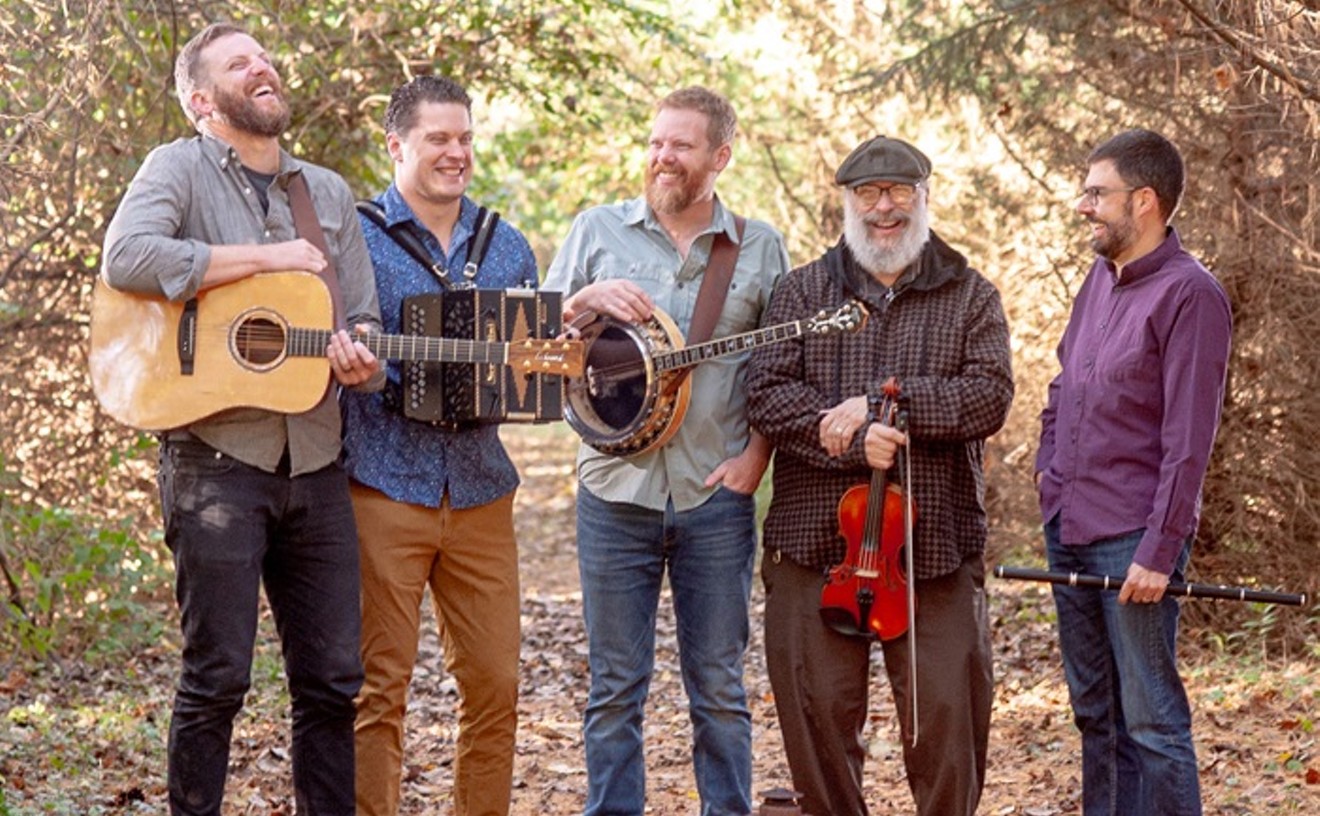
Pittsburgh is a city rich in history, culture, and natural beauty. From the iconic skyline views atop Mount Washington to the vibrant neighbourhoods like the Strip District and Lawrenceville, there is something to delight every visitor. The city’s transformation from an industrial giant to a modern cultural hub is reflected in its diverse range of attractions, from world-class museums and historic landmarks to scenic parks and trendy shopping districts.
Whether you’re a history buff eager to explore the Fort Pitt Museum, a nature lover seeking tranquillity in Schenley Park, or a sports fanatic catching a game at PNC Park or Heinz Field, Pittsburgh offers a unique and unforgettable experience. The eclectic blend of old and new, from industrial relics like the Carrie Blast Furnaces to cutting-edge art installations at the Mattress Factory, makes Steel City a dynamic destination for travellers of all interests.
